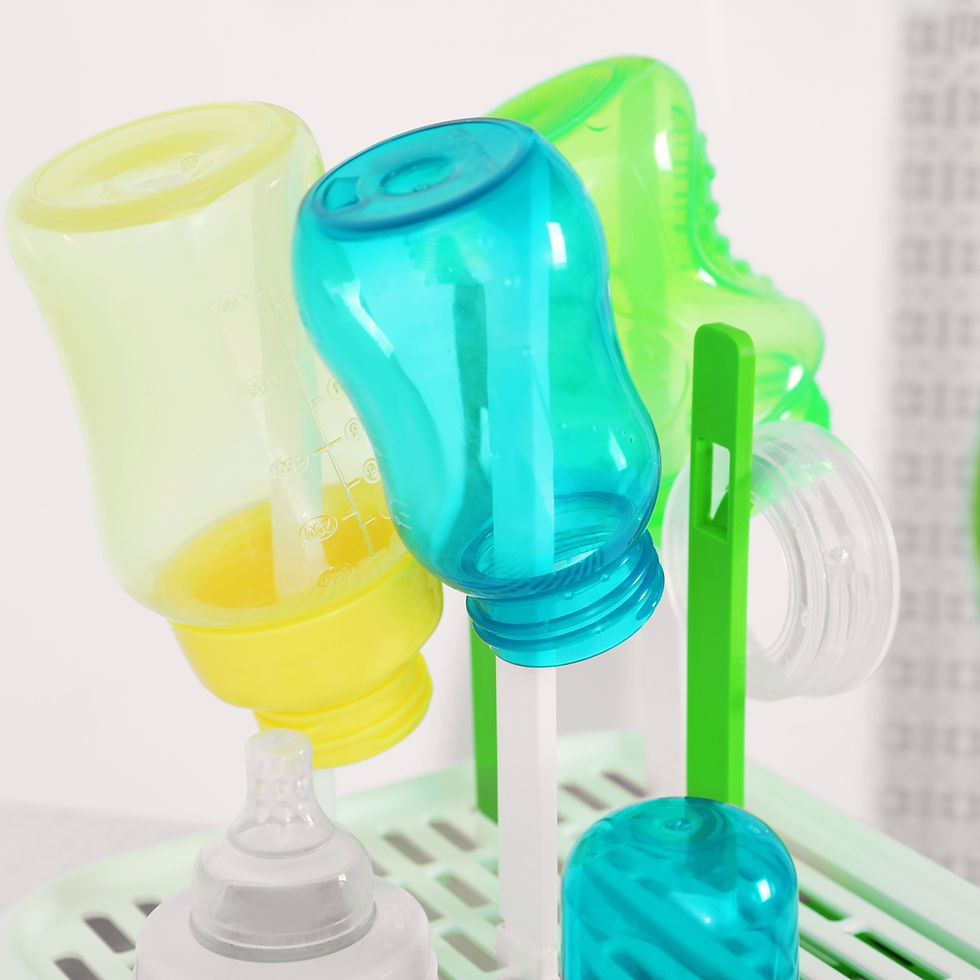Sterilizing Baby Equipment: A Comprehensive Guide for New Parents
- Samantha Pieterse
- Jan 30, 2024
- 3 min read
Updated: Apr 2
This is a question that I get asked frequently and something that I too wondered as a new mother. We all know that as parents we just want to do the most to keep our little ones safe and healthy and obviously sterilizing bottles and other equipment plays a crucial role in this. This is why I decided to to a quick FAQ on the ins-and-outs of sterilizing the equipment.

FAQs
Why do we sterilize bottles and other baby equipment?
Sterilizing baby bottles, feeding equipment and other things like dummies is extremely important in the first 2 months of a baby’s life. This is because at this age they are still developing their little immune systems and are more susceptible to developing infections from bacteria growth on things that go into their mouths. Before the age of two months babies can develop extreme diarrhea or vomiting from bacterial build up on bottles and feeding equipment. They can still develop these symptoms after two months, but it becomes less and less likely as their immune system develops.
What methods can be used to sterilize bottles and equipment?
Before we go into the methods – it is important to note that bottles/equipment must be thoroughly washed before sterilization. Sterilization does not wash bottles but kills bacteria. If there is still residue on bottles/equipment bacteria will begin to multiply again. (This was new to me, pre-mom Sam was under the impression a microwave sterilizer was a mini-dishwasher)
Steaming in the microwave/electric sterilizer – for this method you would need a microwave sterilization container or electric sterilization container. These containers heat up water to produce steam which kills bacteria on bottles/equipment with heat.
Boiling - this method is where bottles/equipment are placed in a pot of rapidly boiling water on a stove top for 5 minutes. In the same way as the steam sterilizers, the heat kills bacteria on the equipment. The equipment should be kept at a rapid boil for 5 minutes for it to be an effective method for killing bacteria.
Cold sterilization solutions (such as Milton) – in this method a sterilizing solution is used to chemically kill bacteria on the bottles or equipment.
Is it necessary to sterilize an item after each use?
Cleaning bottles/equipment in hot soapy water directly after a feed should be sufficient to prevent bacterial growth and you should be safe sterilizing your bottles once a day. It is recommended that sterilizing be done two to three times a day for babies younger than 3 months but there is no harm in sterilizing after each use.
At what age is it no longer necessary to sterilize baby bottles and equipment?
It is recommended that bottles be sterilized up until baby is at least 12 months old. Although, as they get older you can reduce the number of times a day that you are sterilizing. Washing bottles/equipment in the dishwasher on the longest and hottest cycle also provides protection against bacterial growth on the bottles.
Is one method better than another when it comes to sterilizing baby bottles and equipment?
In terms of ease of use and protection against bacterial growth, all methods are about equally effective.
Although the bactericidal effect of using a cold sterilant is about the same as heat sterilization, using a cold sterilant has been found to kill good bacteria in the baby’s mouth and gut as well. With the good bacteria being killed bad fungi called candida may grow causing oral thrush and nappy thrush in babies. Therefore, I would recommend rather using one of the heat methods.
After sterilizing a bottle, how long is it considered sterile for?
If a bottle/equipment is stored and handled well after sterilization it remains sterile for 24 hours. To ensure that your bottle/equipment remains sterile, avoid touching where the bottle/equipment will touch food/milk and where it will be in contact with the baby’s mouth. For example, do not touch the inside or outside of the teat of the bottle (hold it on the plastic ring and do not touch inside of the bottle. Allow to air dry as drying with a cloth will reintroduce bacteria.
In terms of storage – always store bottles upside down. Remember that bacteria grows in warm places, so store your bottles/equipment in a clean, sealable glass or plastic container in the fridge or freezer.
So there you have it, I bet you're probably doing more than necessary. Well done! Remember it's never too late to start and if you haven't been sterilizing as often as you should. You're still doing a great job - so well done!














Comments